This delicious Thai Curry recipe is both vegetarian and vegan. If you want a healthy dinner packed full of bright flavors and hearty vegetables, this is the recipe for you. This Thai Red Curry is a family favorite. If you have a can of coconut milk at the ready, this recipe will come together very quickly and will deliver a ton of flavor.
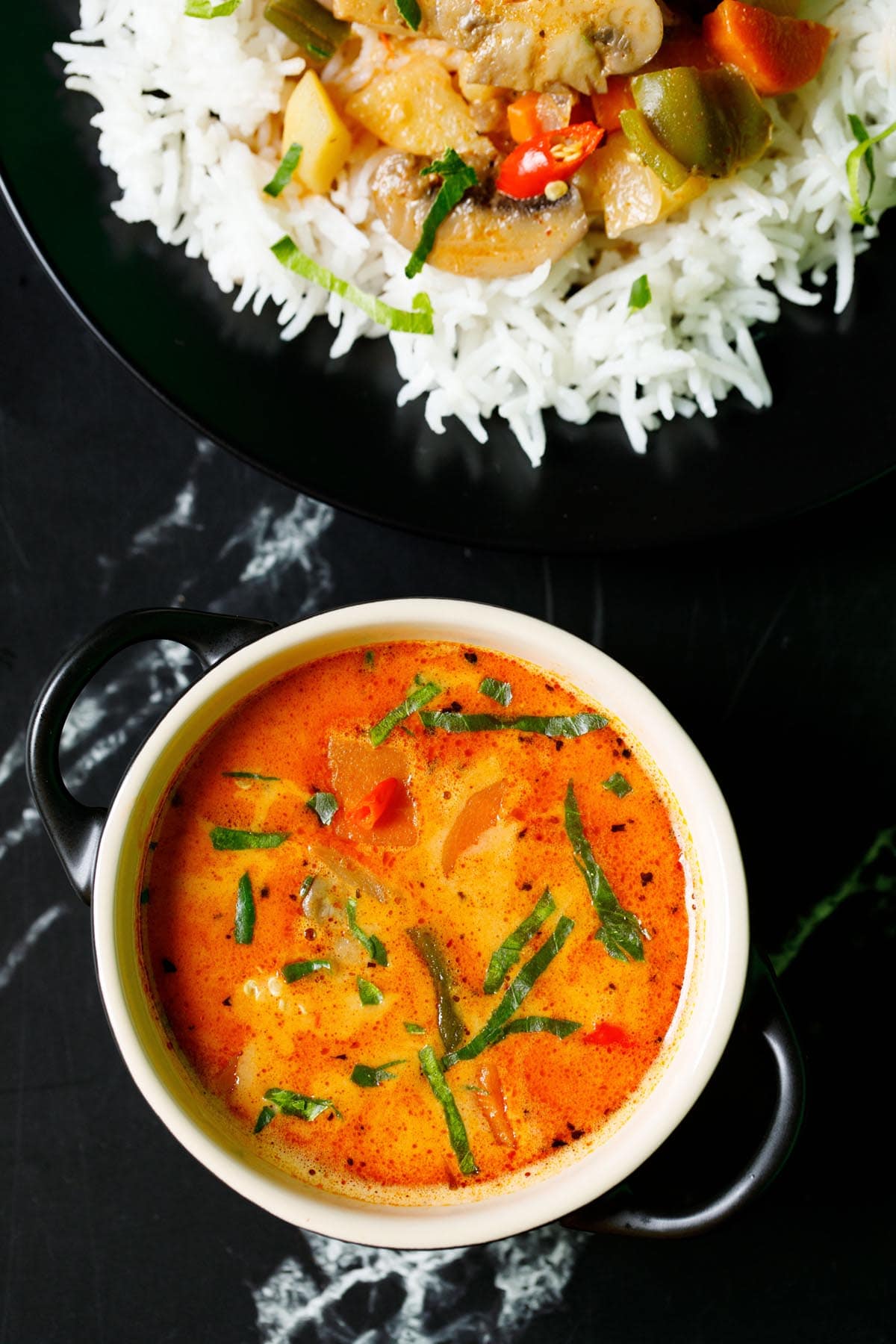
About This Thai Curry Recipe
While I love cooking authentic Indian food, I truly enjoy cooking globally. I have been making this Thai curry for decades and it is a much-loved dish with my family.
If you love Thai red curry and want to make some at home, give this recipe a try. Making your own homemade red curry paste is simple and straightforward, and it tastes so much more delicious than the shelf stable paste you can buy at market.
Making your own Thai red curry paste is also a great way to ensure that your dish is preservative and additive free.
While you can certainly use the store bought stuff in place of making your own, I highly recommend making your curry paste from scratch.
While below I share the recipe for making the red curry paste that is sufficient for four servings of the curry. I also scale this same curry paste recipe and make a big batch to freeze.
Table of Contents
Ingredients You Need
The authentic ingredients you will want to make this Thai red curry paste may not be familiar to you. Galangal, part of the ginger family, has a piquant and spicy flavor.
Kaffir lime leaves impart a bright citrusy flavor, and lemongrass is a quintessential Thai ingredient. If you are unable to find any of these items, feel free to reference the section on “possible substitutes” below.
Aside from those three Thai ingredients, everything else should be simple to find. Hot red chiles, coriander seeds, cumin seeds, peppercorn, soy sauce and coconut milk are pantry ingredients you should be able to find very easily.
Finally, this dish is garnished with Thai basil. While you can substitute Italian basil, Thai basil has a specific flavor profile that will elevate your dish to a truly authentic level. If you can find it in your market, I recommend you purchase it for this dish.
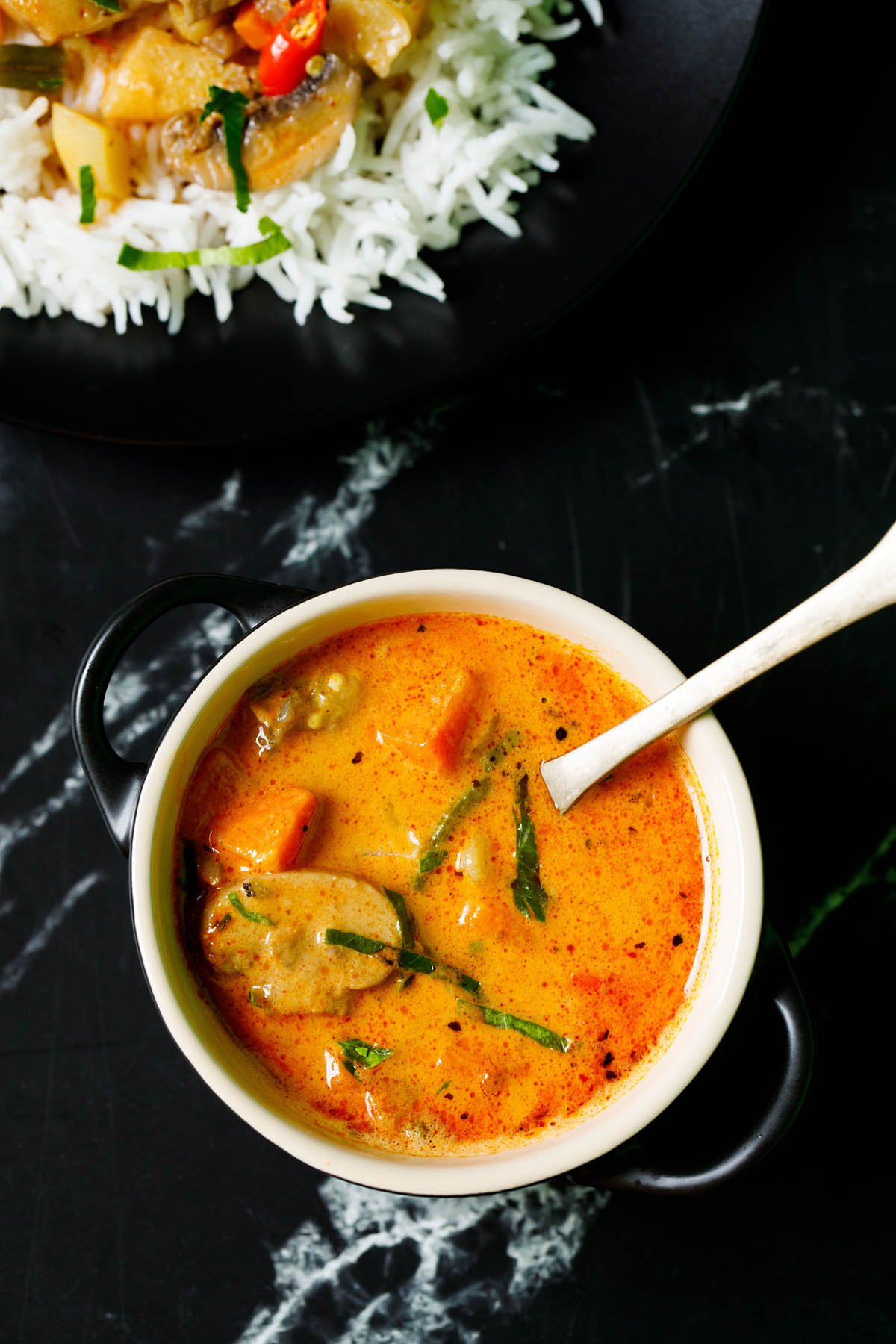
How to make Thai Red Curry Paste
1. Gather the following spices – 2 to 3 bird’s eye chilies, 2 dry red chillies, 2 teaspoons coriander seeds, 1 teaspoon cumin seeds and ¼ teaspoon black peppercorns. The photo below is only to show you the spices.
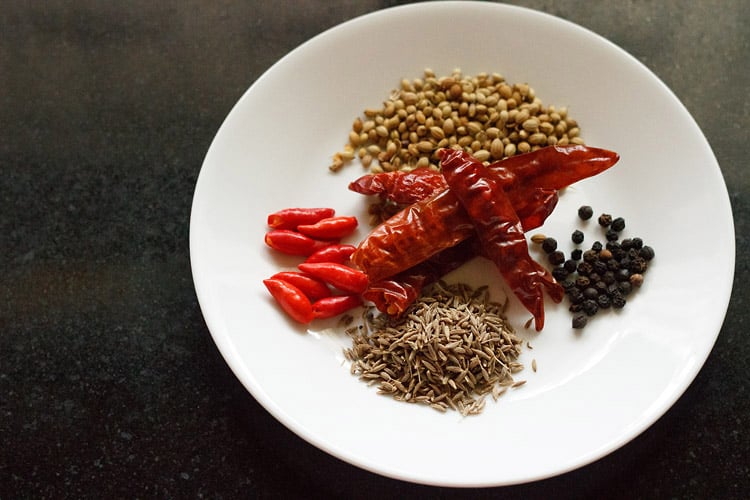
2. Rinse, peel and roughly chop the following herbs – 1 inch galangal, 4 to 5 small garlic cloves (or 2 to 3 medium garlic cloves), 1 to 2 shallots, 3 to 4 medium kaffir lime leaves (chopped) and 2 lemongrass stalks.
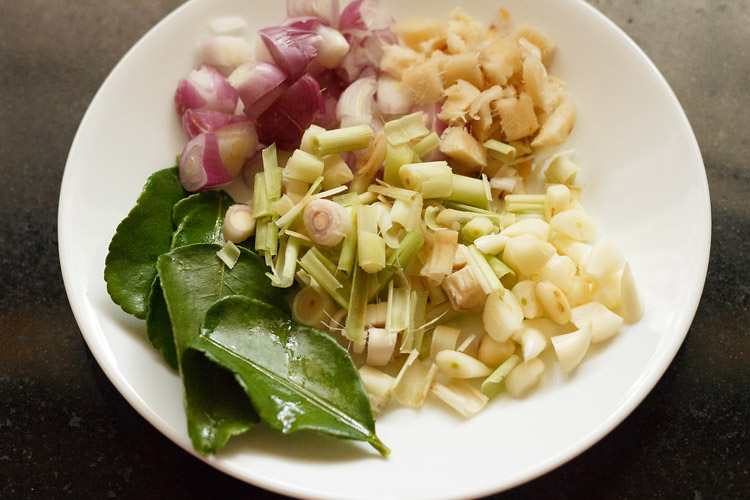
3. Place the spices, herbs, shallots in a grinder jar, food processor or blender.
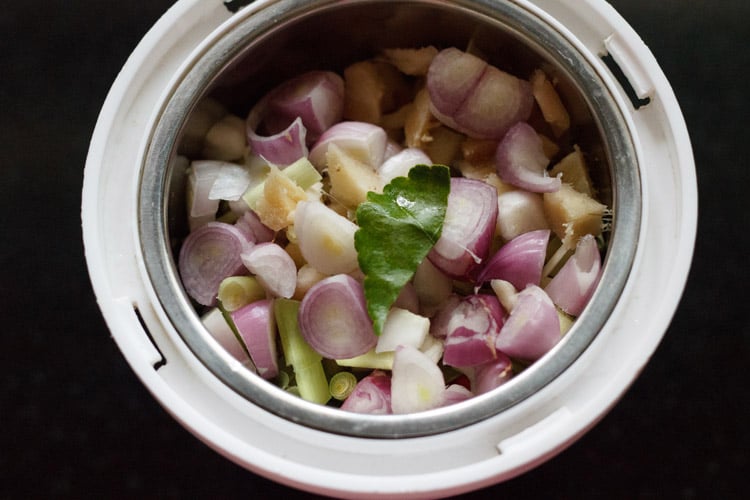
4. Add 1 teaspoon naturally fermented soya sauce, ½ teaspoon lemon zest (optional) and 2 tablespoons water or coconut milk. Also add ½ teaspoon salt or as per taste.
Note to make a large batch of this red curry paste, using water to blend will ensure a longer shelf life of the paste if you freeze it.
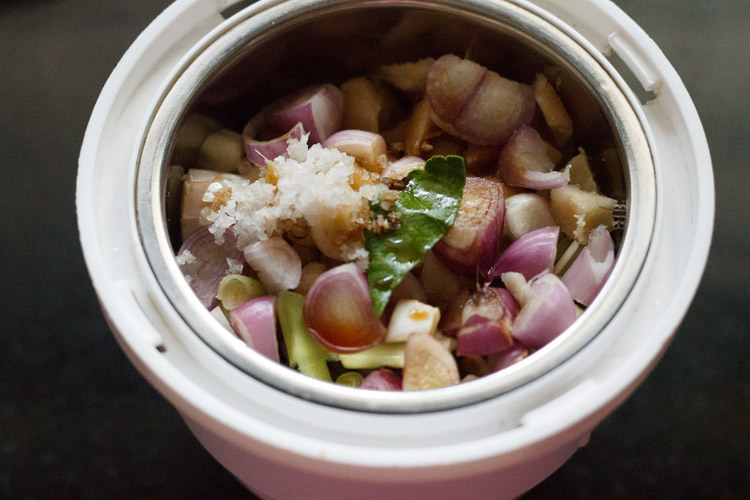
5. Begin to grind or blend the red curry paste ingredients. Scrape the sides and continue to grind to a fine or semi-fine paste.
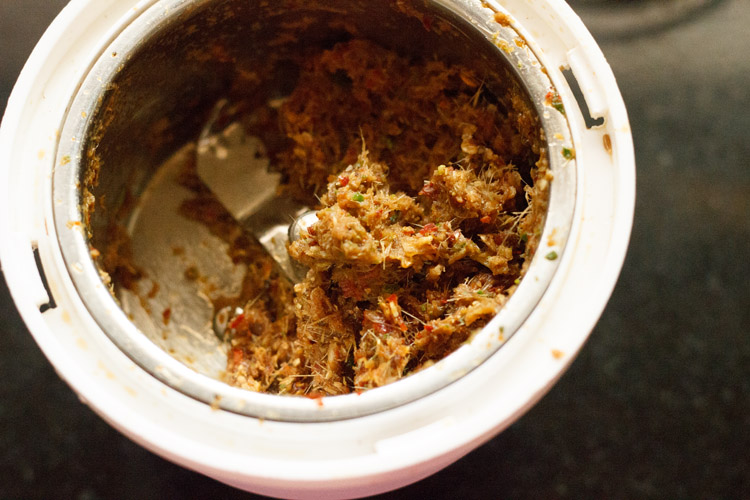
6. I switched to another grinder jar as the first one was not doing a good job of grinding well. I am keeping this photo so that you can see the consistency of the curry paste.
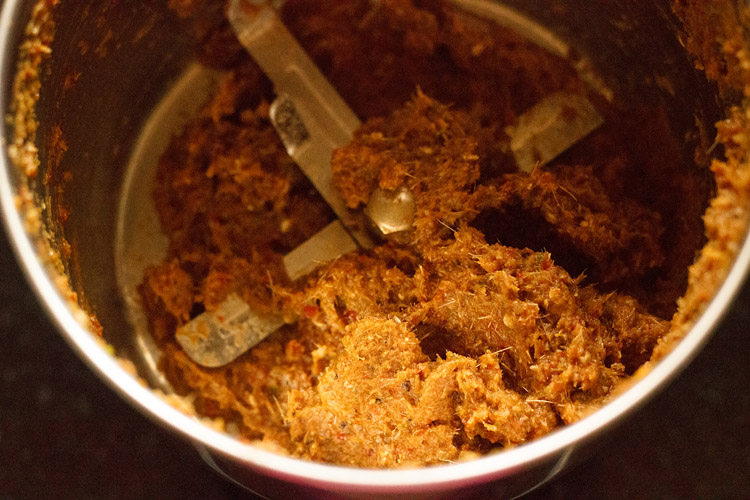
How to make Thai Red Curry With Vegetables
Sautéing Curry Paste
1. In a pot or pan, heat 2 tablespoons toasted sesame oil or coconut oil. Keep flame to a low. Add all of the prepared thai red curry paste.
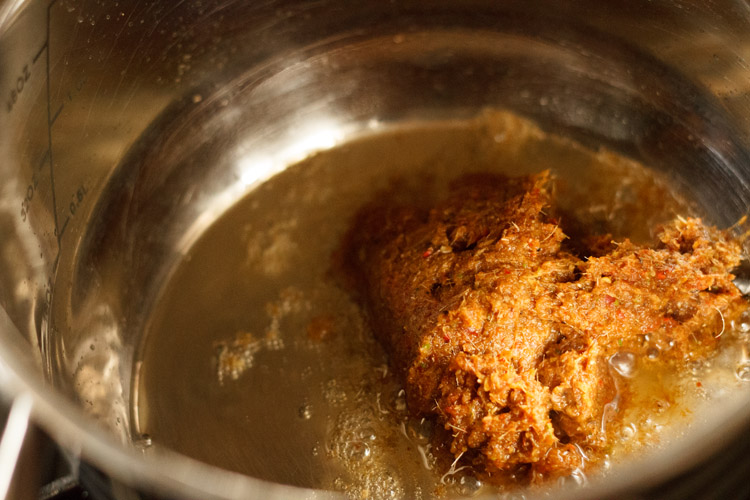
2. Sauté for a minute on a low flame stirring often. It will smell beautifully fragrant.
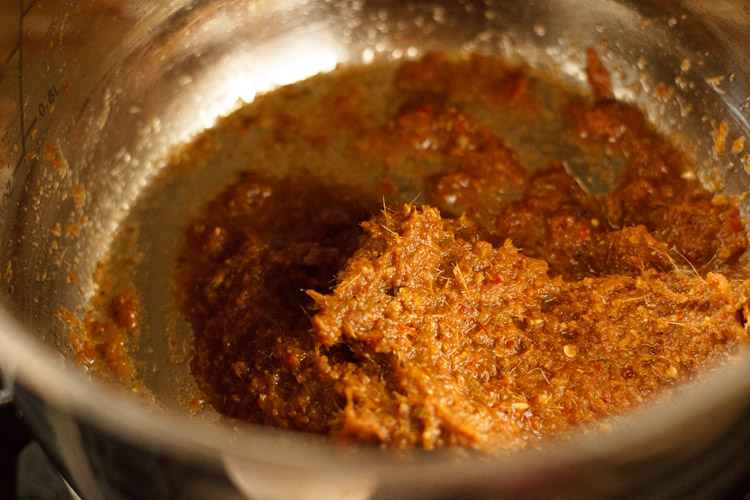
Adding Vegetables
3. Add 2 to 2.25 cups of chopped veggies and white button mushrooms. Stir and mix everything. Here I have included the following veggies:
- ⅓ or ½ cup chopped carrots
- ⅓ cup chopped baby corn
- 1 cup chopped button mushrooms
- ¼ or ⅓ cup chopped capsicum (or any colored bell pepper)
- ¼ cup french beans
- 1 cup chopped cauliflower
- 10 to 12 Thai pea eggplant (turkey berry)
Tip: You can add your choice of vegetables, but keep in mind that certain veggies like zucchini and capsicum require much less cooking and might be better added nearer to the end of cooking. I usually add capsicum at this step. But if you prefer you can add it later.
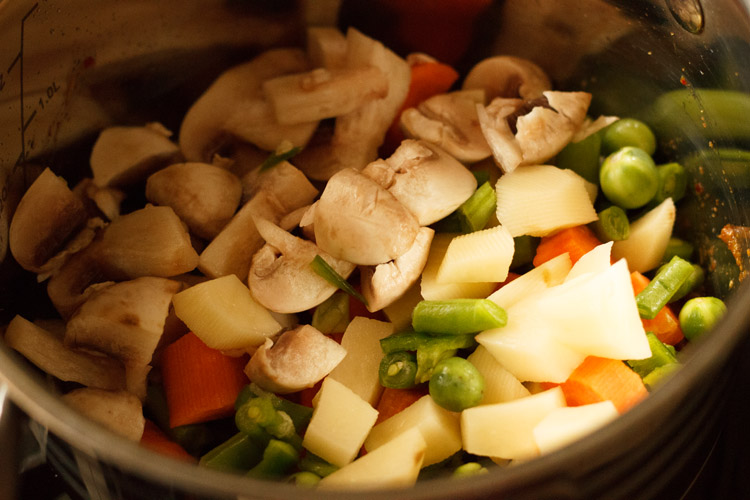
4. Stir and mix everything.
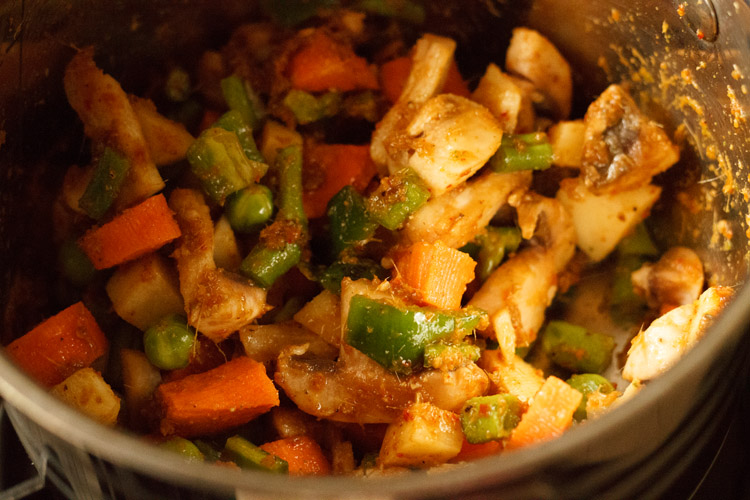
5. Now add ½ cup thick coconut milk and mix again. Keep heat to a low.
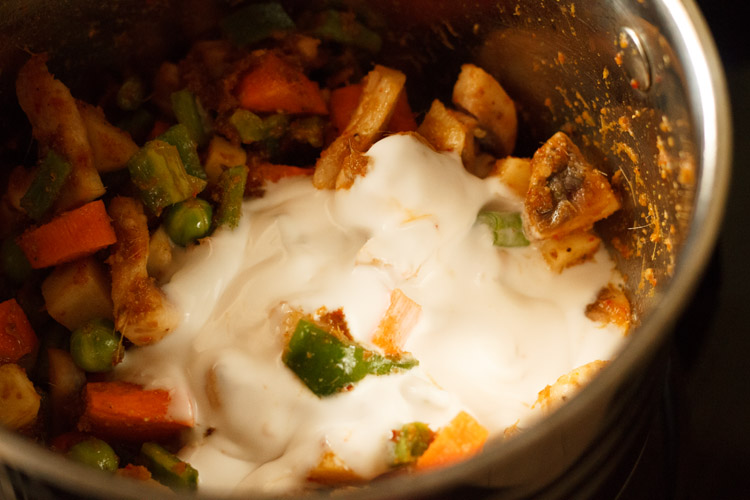
6. Mix again. Keep heat to a low.
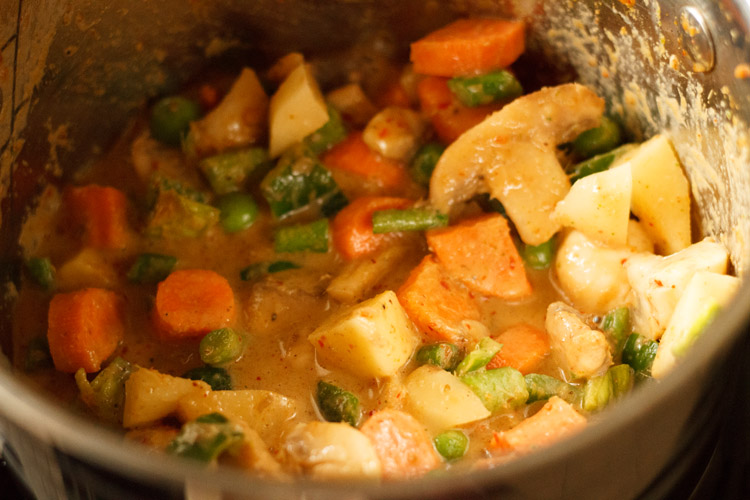
7. Now add about 1.5 cups water and mix again. Since salt was added in the Thai red curry paste, you may not need to add any more. Check the flavor after the dish is cooked.
If you prefer a thicker consistency in the curry then add less water. You can also use homemade vegetable stock instead of water.
Tip: When thinking about salting dishes like soups or curries that will evaporate while cooking, be sure to abstain from adding additional salt until the desired consistency is achieved. This is because while water will evaporate, but the salt will not. If you season for your desired flavor before the water is allowed to dissipate, you will risk over-salting the dish.
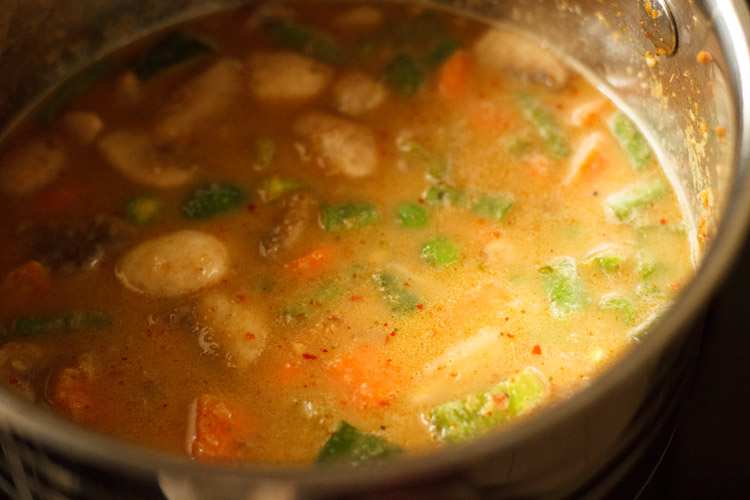
Making Thai Curry
8. Cover the pan with its lid and increase the heat to medium-low. Simmer the curry till the vegetables are cooked through and tender.
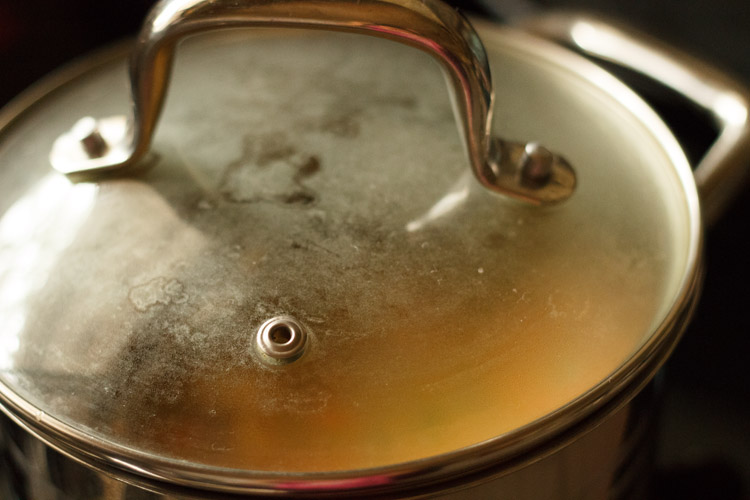
9. Check the curry occasionally while the veggies are cooking. If the water dries up, you can always add more.
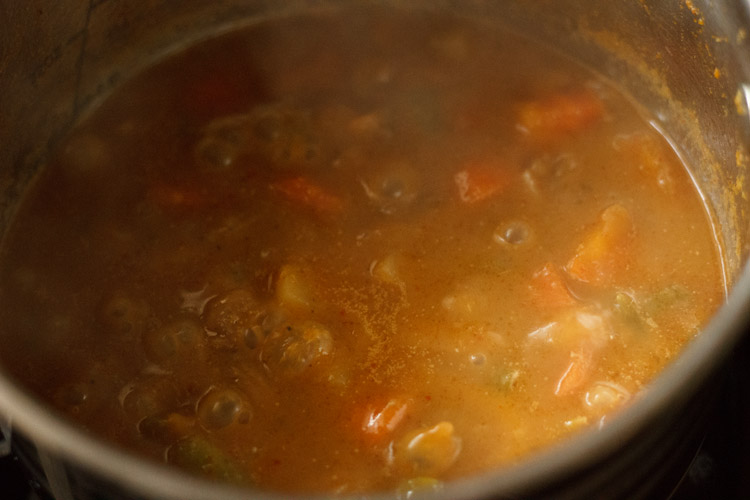
10. When the vegetables are cooked and tender, then reduce the flame to a low and add ½ cup thick coconut milk. You can opt to keep the vegetables slightly al dente if you prefer.
At this step, you can also add ¼ teaspoon palm sugar or unrefined cane sugar. The addition of sugar is optional and can be skipped. For a slightly more sweet taste, you can increase the amount of sugar.
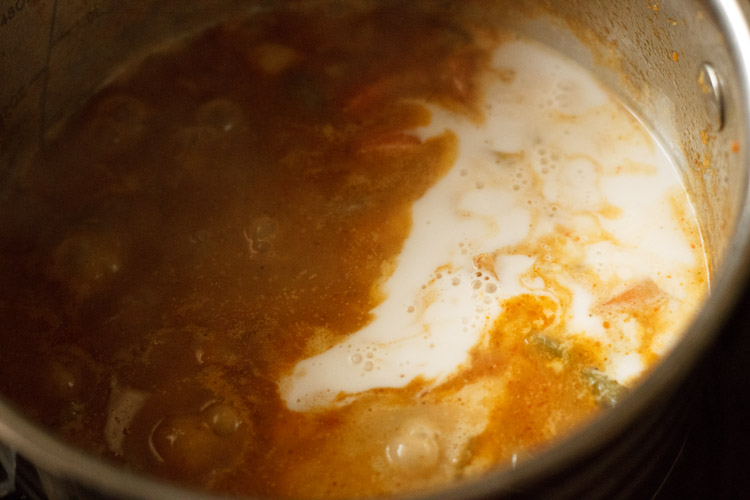
11. Mix very well and let the entire curry come to a boil on a low or medium-low flame. Lastly, add 1 tablespoon chopped or torn thai basil leaves.
Mix and switch off the heat. Check the taste of the curry, and if necessary, add some salt.
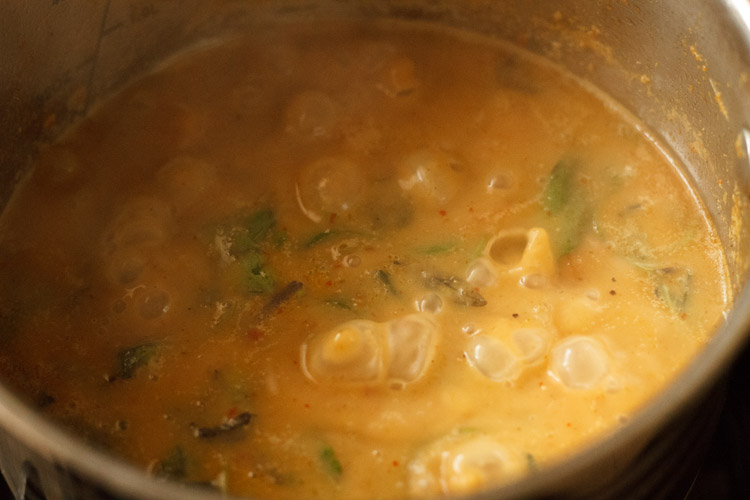
Serving Suggestions and Leftovers
Serve the Thai red curry hot with lemongrass rice, plain steamed basmati rice or jasmine rice. Basil leaves are a beautiful garnish, if you so desire.
Store any leftover curry in the refrigerator for a day. Reheat in a skillet or pan adding some water if the curry has thickened.
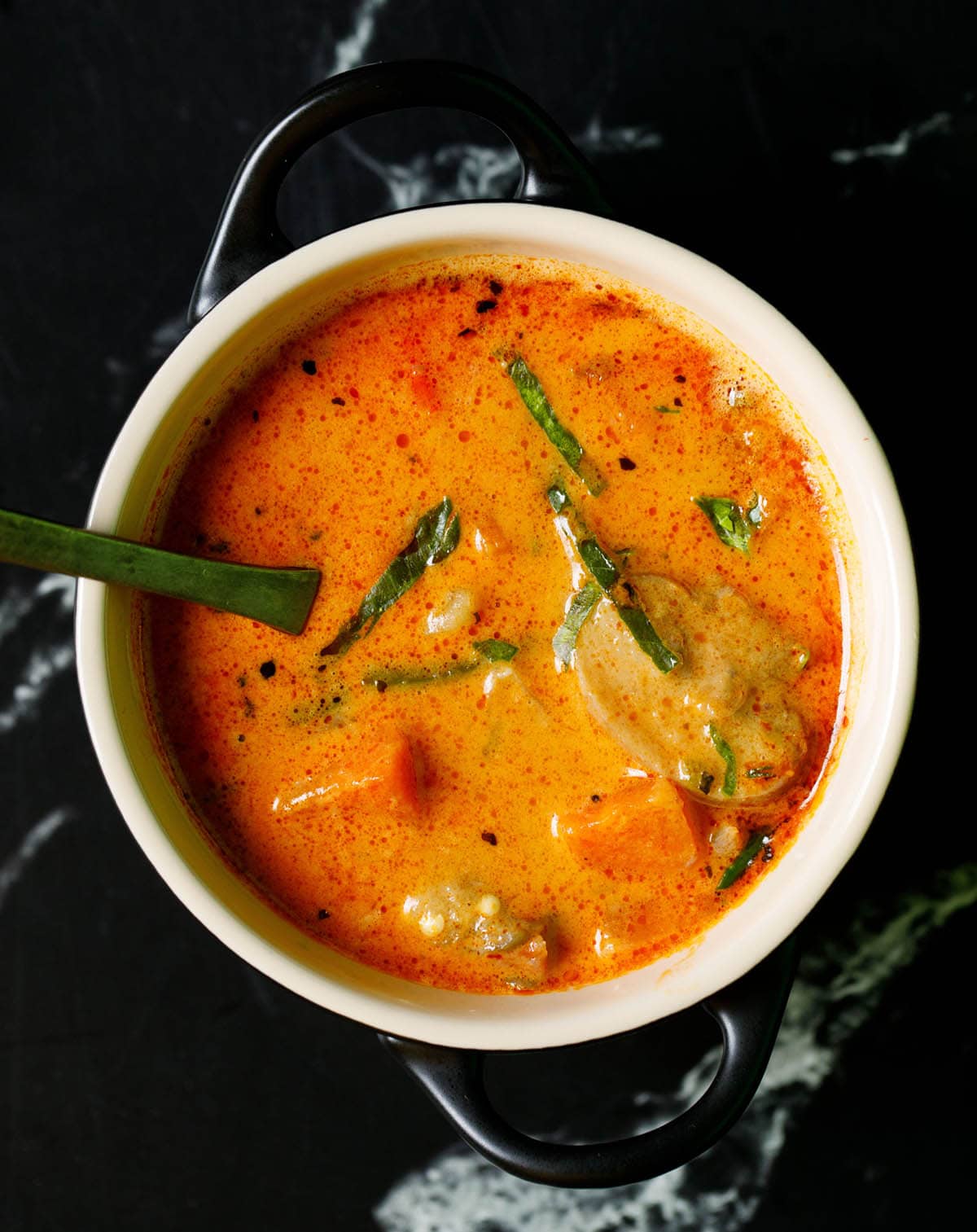
Possible Substitutes for Thai ingredients
While it is suggested that you use all of the authentic Thai ingredients in the recipe, I understand that sometimes you may not have access to everything. Living in Goa and making this recipe was my first hand experience with not being able to purchase some of my favorite Thai ingredients.
These are the substitutes I recommend, but please note that the flavors of the Thai red curry will be affected. While the resulting curry will still taste delicious, it will not be authentic.
- Galangal: use fresh ginger
- Kaffir lime leaves: substitute lime leaves or zest of lemon
- Thai chilies: substitute fresh or dried red chilies
- Shallots: use small onions or pearl onions instead
- Thai basil: Italian basil leaves can be used
- Lemon grass: unfortunately, there really is no comparable substitute to lemongrass. At best, you could use zest of lemon, but you will miss out on lemongrass’s distinctive floral flavor.
If too many ingredients are missing from your market, you can also opt to use store bought Thai red curry paste. I recommend using 3 to 4 Tablespoons in place of the homemade recipe.
FAQs
This dish is traditionally served with aromatic rice. I love serving it with Basmati or Jasmine rice. For a fun fusion, I love serving it with roti or paratha (Indian flatbreads).
I do not recommend that you make this dish without coconut milk. Not only does the fat from the coconut milk create the beautiful, velvety texture of the curry, but it also imparts a lot of flavors.
While soy does impart a particular flavor profile, there are some possible substitutes. First up you could use tamari, which is a gluten free soy sauce preparation. If soy is completely off limits, you could use an equivalent amount of coconut aminos or ½ teaspoon tamarind pulp.
I have made many curries and haven’t experienced curdling when using coconut milk. I would recommend making sure the coconut milk you have on hand is fresh. You can also try adding a teaspoon or so of cornstarch while you’re adding the milk.
Since the paste is made with water, it will last for about 2 days in the refrigerator. You can make a big batch of this paste and freeze it as well. However, if you make the paste with coconut milk, it won’t last long and you have to use it immediately.
Alternatively, you can sauté the paste in some oil, then place it in a jar and cover it with oil to prevent spoilage. Making the paste this way should buy you some additional stability. I would still recommend using it within 2 weeks, if keeping in the fridge.
Galangal is a root from the ginger family, however, their flavors are quite different. While ginger has a sweet heat, galangal is a bit more sharp and peppery.
In Thai cooking, galangal is used frequently.
If you don’t have access to galangal, I recommend substituting equal parts turmeric and ginger. The curry will not be an authentic Thai curry, but will still be delicious.
Also known as Thai or makrut limes, kaffir limes are a citrus that is indigenous to Southeast Asia and Southern China. Both its rind and leaves will emit a strong citrusy aroma.
The leaves are very popular in Thai cooking, but in a pinch you can substitute lime zest for the kaffir lime leaves.
Many online retailers will sell a dried version of the leaves if you are unable to find them in your market.
More Vegetarian Thai Inspirations!
Thai Recipes
Thai Recipes
Thai Recipes
Soup Recipes
Please be sure to rate the recipe in the recipe card or leave a comment below if you have made it. For more vegetarian inspirations, Sign Up for my emails or follow me on Instagram, Youtube, Facebook, Pinterest or Twitter.
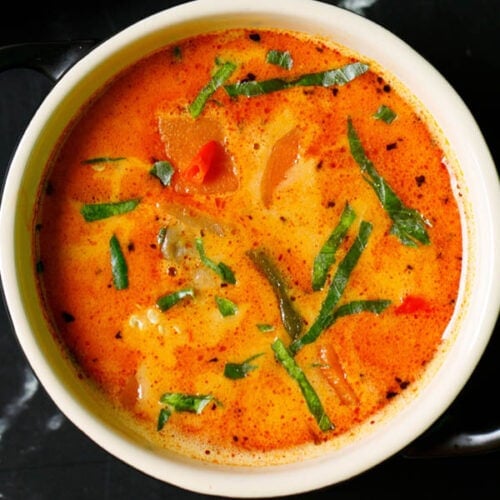
Thai Curry Recipe & Red Curry Paste
Ingredients
For red curry paste
- 2 to 3 bird's eye chilies – red colored
- 2 kashmiri red chillies or low to medium hot variety of dry red chillies
- 1 inch galangal
- 4 to 5 small garlic cloves or 2 to 3 medium garlic cloves
- 1 to 2 shallots or pearl onions
- 3 to 4 kaffir lime leaves – medium sized
- 2 lemon grass stalks
- 2 teaspoons coriander seeds
- 1 teaspoon cumin seeds
- ¼ teaspoon black peppercorns
- 1 teaspoon soy sauce – naturally fermented or brewed
- ½ teaspoon lemon zest – optional
- 2 tablespoons water or coconut milk, add as required
- ½ teaspoon salt or sea salt, add as required
For the thai red curry
- 2 tablespoons toasted sesame oil or coconut oil
- ⅓ or ½ cup chopped carrots
- ⅓ cup chopped baby corn
- 1 cup chopped button mushrooms
- ¼ or ⅓ cup chopped bell pepper – any colored bell pepper
- ¼ cup french beans
- 1 cup chopped cauliflower
- 8 to 10 thai pea eggplant – turkey berry, optional
- 1.5 cups water or add as required
- 1 cup Coconut Milk (Thick)
- ¼ teaspoon palm sugar or unrefined cane sugar – optional
- salt as required – optional
- 1 tablespoon thai basil chiffonade or whole, chopped or torn
Instructions
Making thai red curry paste
- Take the spices and set aside– bird’s eye chilies, dry red chillies, coriander seeds, cumin seeds and black peppercorns.
- Also rinse, peel and roughly chop the following herbs – galangal, garlic cloves, shallots (chopped), kaffir lime leaves and lemon grass stalks.
- Take the spices, herbs, shallots in a grinder jar.
- Add soy sauce, lemon zest (optional) and 2 tablespoon water or coconut milk. Also add salt.
- While grinding, scrape the sides and continue to grind. Grind to a fine or semi-fine paste.
Cooking Veggies
- In a pot or pan, heat the toasted sesame oil or coconut oil. Keep heat to a low. Add the prepared thai red curry paste.
- Sauté for a minute on a low flame stirring often.
- Add the chopped veggies including white button mushrooms. You can add your choice of vegetables. Stir and mix everything.
- Now add ½ cup thick coconut milk. Mix again. Keep heat to a low.
- Next add water. Mix again. Since salt was added in the thai curry paste, it need not be added. But do check the taste of the curry later and if required you can add more salt.
- For a thicker consistency in the curry, add less water.
- Cover the pan with its lid. Increase the heat to medium or a medium-low. Simmer the curry till the vegetables are cooked and tender. Keep them slightly al dente if you prefer.
- In between do check when the veggies are cooking. If water dries up, you can add more water.
Making thai red curry
- When the vegetables are cooked and tender, then reduce the heat to a low and add ½ cup thick coconut milk. At this step you can also add ¼ teaspoon palm sugar or raw sugar. Addition of sugar is optional and can be skipped. For a bit more sweet taste, increase the amount of sugar.
- Mix very well and let the entire curry come to a gentle boil on a low or medium-low heat. Lastly, add 1 tablespoon chopped or torn thai basil leaves. Mix and switch off the heat. Check the taste of curry and if required you can add some salt.
- Serve the thai red curry hot with lemongrass rice or plain steamed basmati rice or jasmine rice. You can garnish it with basil leaves while serving.
Video
Nutrition Info (Approximate Values)
This Thai Curry recipe post from the archives was first published in Feb 2011. It has been updated and republished on June 2021.
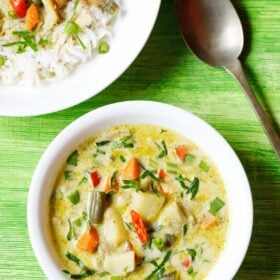
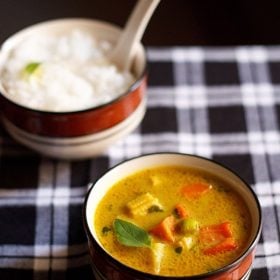
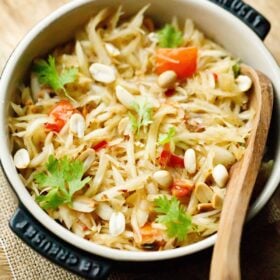
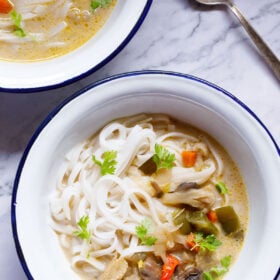








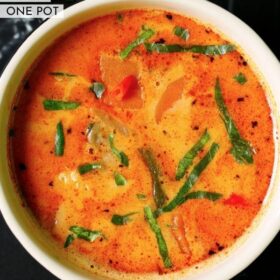
Hello Dassana – is it a Buddhist name, by the way?
I think your blog gives the most accurate measurements for recipes. Every dish I have made from you always turn out perfect. I can trust your recipe completely. Sadly, cannot say the same for many other blogs I have tried to use.
I love the Thai red curry recipe you’ve given here. I have made it several times, and have enjoyed it immensely every time.
Thank you so much and look forward to making many more of your recipes. Do you have any bread recipes?
Yes it is. Thank you for the positive feedback on the recipes. Glad to know that the accuracy of the recipe measurements are helpful. Thanks for the feedaback on the thai red curry too. Yes, I shared many bread recipes and you can check them here – https://www.vegrecipesofindia.com/recipes/bread-recipes/
Can I use small amount of grated coconut instead of coconut milk as –
1) I don’t have coconut milk.
2) My husband not too fond of coconut milk taste.
grated coconut won’t work in the recipe. coconut milk is an essential and important ingredient. so nothing can be substituted in place of that. a suggestion would be to grind half a cup of grated coconut with the rest of the spices, herbs and some water to a fine consistency. then saute the coconut paste for a minute or two stirring non-stop. add vegetables, water, salt. cover and cook till veggies are done. add water accordingly.
Dassana, I am your secret admirer since the first recipe I tried from this site…Chole Masala.
I have tried this thai recipe and many other recipes and keep coming back again and again to checkout something new.
This time, I was happy to see a revised site that gives recipes as per number of people. Going to try the red Thai curry recipe this evening.
Thanks for all your efforts of putting awesome recipes.
thanks a lot kavita. i am glad you commented. it does help for me to know if readers are liking the presentation and layout of the recipe. i am still working on the site and many changes will be implemented gradually. thanks again and wish you all the best.
Hi Dassan,
I loooove your blog and been following your recipes for a while now. I loved each one of your recipe that I tried, but this one blowed my mind away. It was perfect Thai curry and it made my husband fall in love with me all over again. Thank you. And keep the great recipes coming.
thanks so much gayatri for positive feedback and kind words.
Hey I love your recipes as they are healthy and tasty! Keep posting such recipes??
welcome and thankyou krusha 🙂
This recipe looks amazing. I was wondering though, the instructions say to “add the shallots and saute for 2-3 minutes” But, I thought they were ground up in the paste. In the picture it looks like scallions or green onions being sautéed. Am I missing something, or hallucinating? Thanks!
thanks. you are not missing something or hallucinating 🙂 i forgot to mention spring onions. either shallots or spring onions can be added while sauteing.
Hello Dassana..
I simply love to make your recipes..
I have suggestions about curdling..
Add little corn flour to coconut milk.. this will solve the problem..
Thanks
thanks sunita for this suggestion and also for the overall positive feedback.
I love your blog, it’s my go to website for all types of cuisine! I’m having one problem with this recipe… My sauce is curdling, what am I doing wrong?
use thick coconut milk. curdling can be as the coconut milk is not fresh enough. i make thai curries often, but never had any curdling issue.
Hi, I am used to buying a Thai curry paste jar which would last me say a month or two, and I am now looking to try making this on my own. How long does a homemade curry paste keep? What can I do to increase its shelf life?
it won’t keep for very long as coconut milk is added while making the paste. just for a couple of days. thats it. if you make the paste without coconut milk, then the paste stays for a longer time. i would suggest to saute the paste in sesame oil or any oil, so that the shelf life is extended. generally raw pastes do not have a long shelf life. if the oil covers the paste completely, then the paste does not get spoiled. then when making the thai curry, you just add a bit of oil.
I can’t wait to try and make this. It looks fantastic.
This recipe is amazing. It tastes like authentic Thai curry 🙂
Thank you Dassana.
welcome nikhil
Hi,
Can you make this without the soy sauce? I am allergic to soy. If so, what would you use in its place? Thanks!
soy sauce does give its taste to thai curry. generally fish sauce or shrimp sauce is used. may be, just a suggestion you can add a bit of tamarind pulp. very little not much. just about 1/2 or 1 tsp of it.
Tried this dish with readymade red Thai curry paste brought from a super store. Turned out good even without the kaffir leaves. Supplemented it with a few curry leaves.
Realized that red capsicum & zucchini used would have been better tasting had I not boiled it along with other veggies and added directly to retain their crispness & flavor.
Thanks for the procedure explained in such a simple way using pics.
thanks for the feedback krishna. for red bell pepper and zucchini, one does not need to cook them. even sauting them will cook them.
hi dassana can u suggest a readymade thai curry paste?
jyotsna, i have not used any brand till now for readymade thai curry paste. i make at home.
hi, i havent tried making veg thai dishes at home…. i googled and saw ur recipe..it seems v easy and simple… hopin to make it soon..btw with what do u eat this?
you have the thai red curry with rice. plain cooked basmati or jasmine rice goes very well with the thai curries. in fact you can have the curry with any good quality rice.
c’d u plz tell me wht is galangal? my children luv thai curry n so i intend to cook it fr them. also where can i get kaffir lime leaves from?
galangal is a root from the ginger family. it is not at all like ginger. it has a very strong taste and flavor.
you can read more about galangal on my post here – galangal tea
in thai cooking they use a lot of galangal. instead of galangal you can add ginger. the thai curry will not be an authentic thai curry but still very good to taste. when i shifted here, i would not get galangal or kaffir lime leaves. so i started making the thai curry with ginger, lime zest (grated rind of lime), lemon grass and regular italian basil leaves.
fresh kaffir lime leaves would be not easy to get. you can though buy dry kaffir lime leaves, but they are expensive. if you stay in indian metros like mumbai or delhi than you can get the dry kaffir leaves in super stores. in bangalore i would get all the thai and european fresh veggie stuff from the namdhari’s stores.
Hi Dasssan,
I plan to make the Thai red curry paste, can you tell me ready made which one to buy ? to get the exact thai taste
dear janet, i have never bought ready made thai curry paste. i have seen some thai brands, but never bought them. its better to make the paste at home.
since you plan to buy, you can ask the store people about the brand or just have a look at the ingredients gone into the product, which country the product is made, the packaging etc, date of manufacture and expiry date. this is how i buy when i buy things or goods which i have never brought before.
Thanks Dassana….i better make the paste at home… Ready made is too much of TDS i think
One of the best presentation with pictures which will help any body to understand how it will look at each step of the preparation.
Thanks.
thanks manoj
Looks delicious.
thanks thai food lover….
too good recipe
TOOGOOD